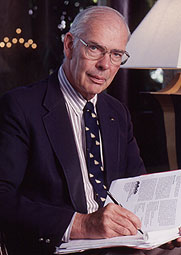Berkeleyan
He's been here for the revolution in communication and access
On the eve of his retirement, CIO Jack McCredie reviews the state of information technology at Berkeley
![]()
| 04 May 2005
 Jack McCredie |
Today, he notes, Berkeley's network boasts 47,000 nodes, and is "something we depend on every day. The implications of having all of us - not just the technological fringe - connected electronically and able to surf the Web is huge."
Evaluating new technologies and determining which ones will serve the university have been the key challenges for McCredie during this "communication and access revolution." McCredie, who is also associate vice chancellor for information technology, will be retiring this summer, after seeing the campus through what would have only recently been regarded, quite literally, as incredible changes in technology.
McCredie cites a number of examples of such changes from his nearly 13-year tenure, not least of which is the creation of the aforementioned campus network. Other highlights include facility and infrastructure improvements, conversion of paper-based systems to Web-based services, and collaborations that reach beyond the university's boundaries:
. The unit McCredie has headed for a dozen years, Information Systems and Technology, recently relocated to a seismically sound, state-of-the-art facility on Hearst Avenue, after weathering decades of flooding and power outages in its former home in the basement of Evans Hall.
. Impelled by outmoded financial-management applications and Y2K worries, campus leaders developed the Berkeley Administrative Initiative in 1998 and upgraded what McCredie calls the campus's "creaking 30-year-old financial systems," then later introduced the Human Resources Management System (HRMS).
. e-Berkeley, an initiative to promote innovative approaches to making campus services available on the Web, was launched in 2000 and spawned numerous online applications, including e-Grades, webcasting of selected courses and campus events, credit- and debit-card payments, and improved course information and registration.
McCredie, who is on the board of directors of Internet2, the nation's high-performance education and research network, makes special note of the campus's collaborations with outside entities, both in higher education and the private sector. All UC campuses, for example, belong to the UC Information Technology Leadership Council, where as a system they work together to share best practices, develop common approaches, and negotiate the most competitive contracts for each campus. The campus is also one of 25 research universities participating in the Common Solutions Group, an organization that tackles technology problems common to such institutions. The university is also part of Sakai, a consortium that has been developing an open-source course-management system, the result of which will be piloted on campus in the fall.
Missed opportunities
McCredie's impending retirement has made him willing to review the past without glossing over disappointments. As eager as he is to tout the campus's technological progress, he's equally open to examining missed opportunities and future challenges.
"One area where we have not used information technology as much as possible is teaching and learning," asserts McCredie. "If Socrates came back and wandered around the campus, he would recognize a lot of what we're doing." What the ancient Greek pedagogue would witness would be a "largely lecture-based operation," one in which "we haven't yet found ways to use technology effectively to address people's different learning styles."
He contrasts that with the progress made in general research, an endeavor that is notably different in almost every field than it was a decade ago. For example, scholars can accomplish any number of data-intensive and library-centric tasks without leaving their computer - from locating old journals to purchasing manuscripts online.
To effect change in teaching and learning, wiring classrooms and installing wireless connectivity around campus is not sufficient, contends McCredie. These technological improvements "don't do anything unless faculty find pedagogically based applications for them in the classroom." The problem, says McCredie, is that faculty are rewarded in a tenure system mostly for their research, not for integrating technology and teaching, so there's a lack of incentive to devote time to the latter. He does concede, however, that "it is certainly easier to use information technology in research than it is in teaching and learning. We need to develop better tools to help faculty innovate with technology in their courses."
One problem that has long been the bane of McCredie's existence, the lack of campus computing standards, is getting overdue attention. "For example," he says, "in addition to CalMail, the campus e-mail system, there are several dozen e-mail systems supported by departments. We don't have a governance structure in place that enables us to do effective cross-departmental systems planning, to implement crucial policies to protect sensitive personal information stored on computers throughout the campus, or to purchase applications at the lowest cost." Says McCredie: "Every department is an island unto itself and often operates independently."
An information-technology review committee, chaired by Provost Emeritus C. Judson King, will convene for its first meeting this month to examine IT governance, funding, and structure on the campus. That committee, created by Executive Vice Chancellor and Provost Paul Gray, will include Jay Stowsky, former associate dean of the Haas School of Business and the IT study group's project manager, several campus leaders, and consultants external to the university.
"Our quest should be to discover how to take the almost magical advances we see on a regular basis in information technology," says McCredie, "and use them to integrate research, teaching, and outreach into a unified learning environment that is the essence of Berkeley."

